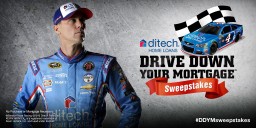In part one of my interview with Rich Smith, CMO of Ditech Financial, we focused on Ditech’s sponsorship of NASCAR and how that helped build broad awareness for the brand. In part two, we’ll broaden the lens and explore the brand’s overall strategic approach, internal training to improve the customer experience and a program that aimed at improving brand loyalty (offering another great example of the power of “marketing as service” in action). There’s a lot of meat in here so I’d encourage you to read the interview carefully but I would be remiss if I didn’t point out a few highlights:
- Ditech is gaining customers without being the low cost provider;
- Increased employee training helped to remove the friction from the buying process;
- By delivering an unexpected progress report to current customers, Ditech improved loyalty;
- While CMO’s can’t be expected to control the entire customer experience they can be the “voice of the customer” across the organization.
All of this should leave little doubt why he won the Marketing Innovation Award from The CMO Club late last year.
Drew: Let’s talk about some of the innovative things you initiated in 2015.
I think we’ve done a lot of innovative things with our brand message and how we are reaching consumers. Most brands in the industry either compete purely on price or they compete purely on a quick and easy transaction. We’re certainly very competitive on price, but we’re not the lowest. We also strive to provide a very convenient transaction process. Taking it one step further, we position ourselves as a partner that can be trusted in the mortgage process, who understands customer needs and won’t put them into the cookie cutter, one-size-fits-all, thirty-year fixed product. Customers are trying to find the best fit for them and we think Ditech offers that. Our Home Loan Specialists are educated to work with customers by asking questions, building rapport and finding solutions.
Drew: How did this translate to into you brand messages?
We have a certification program for our home loan specialists that helps them take a more personalize approach with each customer and we’ve found a way to work that training into our brand message. For example, we mail our current customers a “report card” on their current mortgage that tells them where they are and how they could change their plan by refinancing. These report cards could also tell them about the value of their home and even when there is no opportunity for them to refinance. We call this our Smart Watch Report and it’s a health of your mortgage report. You don’t see that from other providers. We are really transparent with our customers when it comes to what they currently have and what their opportunities are. That’s the theme we strive for throughout our business. We find that transparency with customers generates trust.
Drew: I suspect social media customer service is lot harder in the financial services industry because you have so much sensitive data. How do you use social media as customer service?
We definitely have to be sensitive to that and we have. We are very good at responding to the common issues we hear from customers on social media but if they’re upset, we then try to get them offline as quickly as possible and service them in a way that’s private such as on the phone or e-mail or gather more information and provide a solution to their situation.
Drew: How do you handle privacy on social customer service?
We have a customer care team that handles all the escalations. But certainly any time that somebody posts something like an account number, social security number or any private or secured information we either delete it or advise the customer to do so because you can’t have private information like that out there. And then we also obviously try to get the conversation offline as fast as we can.
Drew: Can you give me a specific example of how customer-centric approach to marketing has translated into some form of out-bound marketing, whether it’s TV or print?
The one I just mentioned was our direct mail campaign with the Smart Watch Report. That is one of our most successful retention marketing programs because people really appreciate getting that information. They call our home loan specialists about their options; it’s very engaging for the customers. And we are in the midst of taking that beyond just one direct mail medium to make it digital in the future which is very interesting.
Drew: Interesting. And so, how important is retention to the acquisition process?
That’s a very interesting question. It’s important in not necessarily a direct way but it’s important perhaps in an indirect way for a couple of reasons. In as much as you do a great job of servicing and retaining customers you have happier customers who then write more positive reviews about you and influence other people to seek you out or consider doing business with you. So that’s a nice indirect benefit. Also, the better job you do at retention the more financially sound your business is and the better base you have from which to grow. Any company that can’t do a good job of keeping its own customers probably is not going to do a good job of acquiring new ones.
Drew: I think that’s a fairly safe bet although I have worked with clients who put all their energy into acquisition and just kept watching the retention numbers decline.
Yes, you can’t fill the bathtub if you have a big hole in it. Just from an ROI perspective on marketing campaigns, the ROI on retention campaigns are many multiples higher than the ROI on acquisition campaign. It’s been true in every business that I’ve worked in my entire career.
Drew: One of things I’ve seen happen to other brands when they start advertising on TV is that their cost per clicks go down on Google Adwords. Increased awareness translates into better SEM performance because people are more familiar and click faster and therefore you can bid lower. Have you seen this?
We are seeing growth but it is a little hard to identify direct impact in SEM. We are definitely seeing more and more organic growth throughout the year, which is a clear indication of rising brand awareness. We did an extensive brand awareness study right before we launched and we repeated it about six months ago and saw major improvements in overall brand awareness and brand favorability. So, we know that it’s having an impact; it’s difficult to parse that out from the other things that we’re doing.
Drew: How much control do you have over the customer experience as CMO? How much influence do you have on this other areas?
I would say that the only person in any organizations that has complete control over the customer experience is the CEO. I can’t say that I control it. One of the most important roles that I play on our leadership team is to be the voice of the customer. I take on the responsibility of bringing the customers insights forward so that they are considered in all of our decision making. As we look to make changes in the future on both the origination side and the servicing side of our business, I definitely have a prime seat at the table to influence and emphasize the importance of the customer experience.

